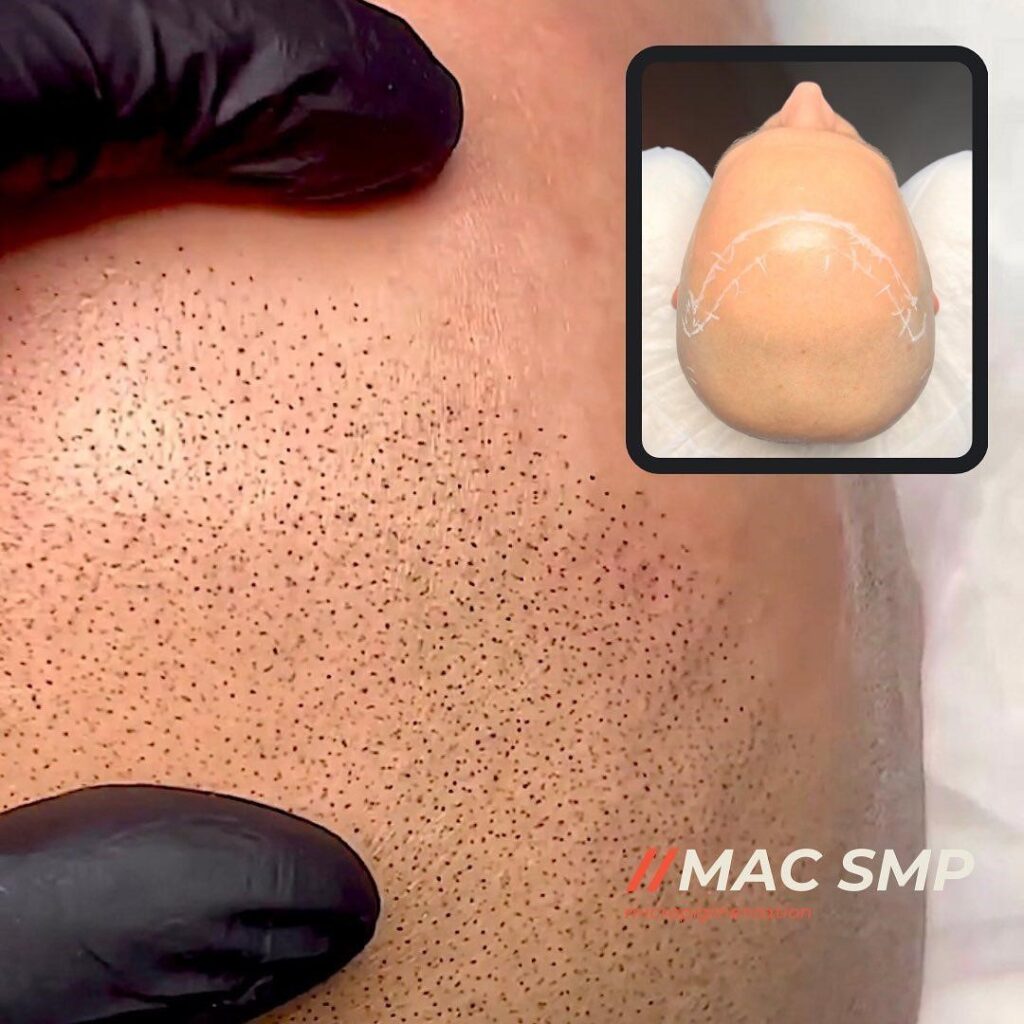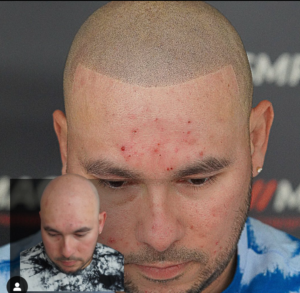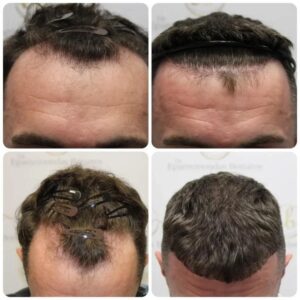
No one likes to lose their hair, but it’s a reality for some people. If you’re faced with hair loss, don’t worry – options are available. One of those options is a hair loss tattoo, also known as scalp micropigmentation (SMP).
While the idea of a hair loss tattoo might seem unconventional, it can be an effective way to cover up bald spots and give your scalp a more uniform appearance.
In this guide, we’ll walk you through everything you need to know about hair loss tattoos – from what they are to how to choose the right one for you. Keep reading for all the information you need on this unique form of self-expression!
Table of Contents
Key Takeaway
Hair loss can be difficult to deal with emotionally and physically. While many hair loss (HL) treatments are available, some people opt for a more permanent solution: a hair loss tattoo. This tattooing technique uses pigment to fill the balding areas of the scalp, creating the appearance of a fuller head of hair.
The results can be quite natural-looking, and the tattoo can be customized to match the individual’s hair color and style. While a hair loss tattoo is not a true cure for baldness, it can provide significant psychological benefits for those struggling with the condition. It might be the perfect solution for those tired of hours spent in the salon trying to cover up their thinning hair.
What is Scalp Micropigmentation?
Hair loss can throw your confidence for a loop, but ditch the hats and hairpieces – scalp micropigmentation (SMP) might just be the game-changer you’ve been waiting for. Confused? This in-depth guide will answer all your burning questions, proving SMP is an effective hair loss tattoo.
Forget the harsh lines and bold colors of traditional tattoos. SMP is a sophisticated cosmetic procedure that utilizes tiny needles to deposit microscopic pigment dots onto your scalp. These dots mimic the look of hair follicles, creating the illusion of a fuller, buzzed hairstyle or adding density to thinning hair. It’s a subtle, artistic redefinition of your hairline and scalp texture.
Who is Scalp Micropigmentation for?
The beauty of SMP lies in its versatility. It’s a beacon of hope for anyone experiencing:
- Male or female pattern baldness: SMP can camouflage receding hairlines, thinning crowns, and even complete baldness with a convincing buzz cut effect.
- Scarring: Whether from surgery, burns, or alopecia, SMP can discreetly blend scars into the surrounding scalp.
- Thinning hair: Add depth and fullness to thinning hair, boosting confidence and eliminating the need for constant styling.
- Alopecia: SMP can create the illusion of hair follicles for those with patchy or complete hair loss due to alopecia.
Does Scalp Micropigmentation Grow Hair?
Hold your horses; hair growth isn’t on the menu! SMP is purely cosmetic, meaning it won’t magically sprout new follicles. However, it can do wonders for your confidence and mental well-being, potentially alleviating the emotional burden of hair loss; that is why SMP is popularly known as a hair loss tattoo.
What is a hair loss tattoo?
A hair loss or scalp tattoo is a type of tattoo that helps create the appearance of hair on a person’s scalp. This can benefit people experiencing hair loss due to medical conditions such as alopecia or a treatment causing hair loss such as chemotherapy.
HL tattooing is done by depositing pigment (tattoo ink) into the skin using a needle and tattooing machine. The pigments will be matched to the person’s existing hair color to create the appearance of hair cut very short.
How can a hair loss tattoo help?
Hair loss can be a major source of insecurity for many people. It can affect your self-esteem, confidence, and even your career. If you are struggling with hair loss, you may consider hair loss tattooing as a solution.
Hair loss tattooing, or scalp micropigmentation, is a minimally invasive procedure that uses tiny needles to implant pigment into the scalp. This creates the appearance of hair follicles, giving the illusion of a fuller, thicker head of hair.
A hair loss tattoo is a medical procedure that can help HL sufferers by camouflaging their hair loss. It is often a recommended treatment for hair loss because it will look like natural hair and give the appearance of a fuller head of hair.
This can be an excellent option for those who are self-conscious about hair loss and want to boost their confidence. It is important to note that a hair loss tattoo is not a cure for HL but can effectively disguise it.

What Happens Before a Hair Loss Tattoo?
Preparation is key for a smooth SMP journey. Here’s what to expect:
- Consultation: Discussing your aesthetic goals, scalp health, and medical history with a qualified practitioner is crucial.
- Scalp assessment: Your practitioner will analyze your hair loss pattern and skin tone to determine the ideal pigment color and technique.
- Treatment plan: A customized plan will be created, outlining the number of sessions, density, and hairline design.
What Happens During a Hair Loss Tattoo?
SMP is different from your typical tattoo experience. Imagine it as a delicate pointillism masterpiece on your scalp:
- Numbing cream: Comfort is a priority, so a topical anesthetic will be applied to minimize discomfort.
- Micropigmentation: Using a specialized device, the practitioner will meticulously deposit pigment dots, mimicking hair follicles.
- Multiple sessions: Depending on your desired density and coverage, 2-4 sessions are typically needed, spaced a few weeks apart.
What Happens After a Hair Loss Tattoo?
Following your SMP session, here are some things to anticipate:
- Mild swelling and redness: These are normal post-procedure reactions and usually subside within a few days.
- Aftercare: Follow your practitioner’s aftercare instructions for gentle scalp cleansing and sun protection.
- Touch-ups: Minor adjustments might be needed after a few months to maintain optimal results.
Do Hair Tattoos Really Work?
Yes. Hair tattoos, or scalp micropigmentation, can provide a successful camouflage for hair loss. However, it’s essential to manage expectations.
The procedure is not a permanent fix, as the implanted pigment will naturally fade over time due to factors like sun exposure and skin turnover.
Regular touch-up sessions may be necessary to maintain the desired appearance, ensuring that the illusion of hair follicles remains consistent and convincing.
How Long Does Hair Tattoo Take To Heal?
After undergoing hair tattooing, the scalp needs time to heal. This process generally spans around 7 to 10 days. During this period, it’s common to experience redness, swelling, and the formation of scabs around the pigmented areas.
Resisting the urge to scratch or pick at these scabs is crucial for proper healing. Such actions can lead to complications, including infections or scarring, that might extend the healing timeline and compromise the final results.
Hairline Tattoo for Male
Hairline tattooing is an effective solution for males with receding hairlines or bald spots. Hairline tattoos can help men achieve a rejuvenated appearance that enhances their overall look by recreating a natural hairline through pigmentation.
Hairline Tattoo for Female
Hairline tattooing is not exclusive to males; it’s also a viable option for females. Women experiencing thinning hair or desiring a more defined hairline can benefit from this procedure. It allows achieving a fuller hairline and altering its shape to better frame the face. Here is an ultimate guide for women’s hair loss treatment.
What to Expect from a Hair Loss Tattoo?
When you get a hair loss tattoo, your technician will first design a hairline that suits your face. Then they’ll choose the pigment color to match your natural hair, after which they will use a tattoo machine to apply the pigment to your scalp.
Several sessions might be required. A session usually takes around two hours, and you can see the results immediately. The hair loss tattoo will last about three years, after which it will start to fade.
Remember, finding a reputable specialist with experience in this procedure is essential to get the best possible results.

Four Benefits of Hair Loss Tattoos.
A hair loss or hairline tattoo can have both psychological and physical benefits. For many, the most significant benefit is the boost in confidence that will come with appearing to have a full head of hair.
Another benefit of hair loss tattoos is that they can help protect your scalp from the sun. This is especially important for those who have hair loss due to medical conditions that make their skin sensitive to sunlight.
Other benefits of a hair loss tattoo include:
- It is a pain-free alternative to hair transplant surgery.
- The results are immediate, and the tattoo will last for several years.
- It is much less expensive than hair transplant surgery.
Finally, hair loss tattoos can help you save money on hair products. A hair tattoo can be a more permanent and cost-effective solution than hair thickening products or extensions.
The Drawbacks of Hair Loss Tattoos.
The procedure involves tattooing tiny dots of ink on the scalp to create the illusion of hair that is cut very short. While it might sound like a convenient solution, a few potential drawbacks exist before committing.
For starters, the results are not permanent. Scalp micropigmentation will eventually fade over time, so you’ll need to go back for touch-ups every few years to maintain the desired look.
Additionally, there is always the risk of adverse reactions to the ink, resulting in irritation or scarring.
And lastly, hair loss tattoos can be costly, with an average price starting at around $500 per session. So, considering this route, consider all the pros and cons before deciding.
How to Get the Most Out of Your Hair Loss Tattoo?
If you’ve decided that a hair loss tattoo is right for you, there are a few things you can do to ensure you get the best possible results.
First, research and find a reputable technician who has experience with this type of procedure.
Next, discuss your expectations with your technician beforehand so they can create a plan that meets your needs.
And finally, be sure to take care of your tattooed scalp by using sunscreen and avoiding excessive sun exposure.
Hair Loss Tattoo Cost
The cost of hair loss tattooing can vary significantly based on several factors. These factors include the extent of the area to be treated, the practitioner’s experience and reputation, and the procedure’s geographical location.
Generally, individuals considering this option should anticipate costs ranging from $2,000 to $5,000. This financial investment should be weighed against the potential emotional and psychological benefits of the procedure.
Thankfully, MacSMP offers a flexible payment plan, so you don’t have to break the bank to look awesome. Click here to book an appointment for a free consultation now.
Conclusion
Both men and women struggling with hair loss can benefit from cosmetic tattooing, a procedure that involves implanting pigment into the scalp to replicate tiny hair follicles. This solution offers a semi-permanent approach to address thinning areas and conditions like alopecia areata.
However, individuals must consider potential side effects and follow proper aftercare, especially if they engage in heavy exercise or opt for a buzz cut to complement their rejuvenated hair and scalp appearance.
A hair loss tattoo can be a convenient solution for those looking to camouflage hair loss. However, there are a few potential drawbacks to consider before committing.
These include the fact that the results are not permanent, there is a risk of adverse reactions, and the treatment can be costly.
Find a reputable technician, and take proper care of your tattooed scalp. By following these tips, you can help ensure that you get the best possible results.



